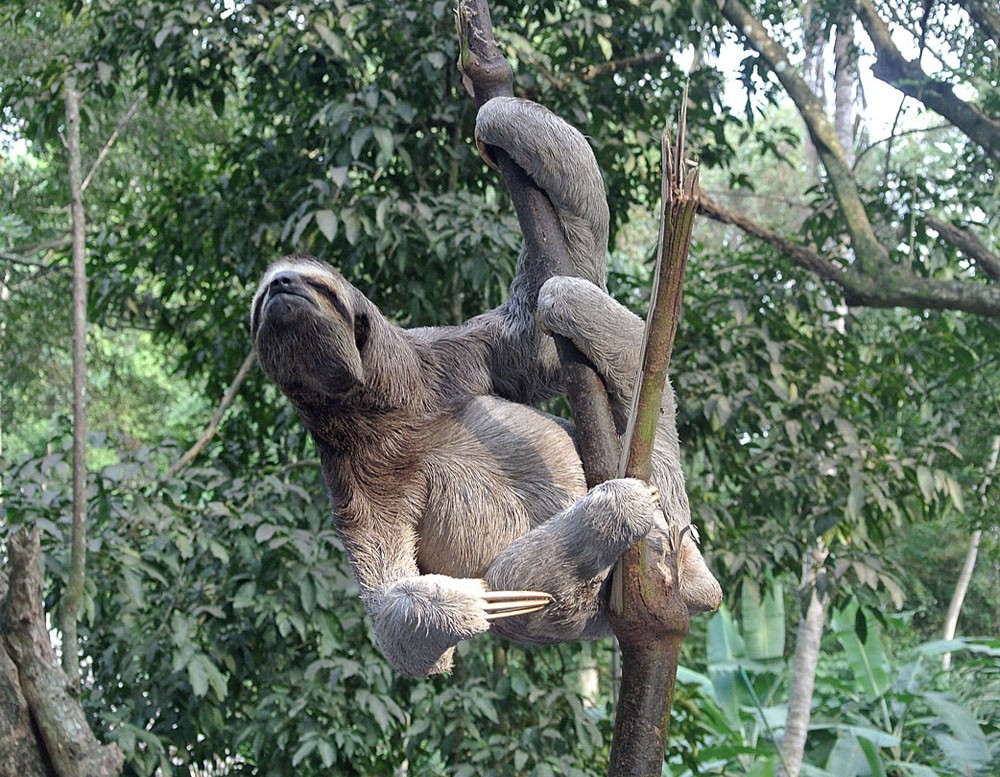Brown-throated sloth
A species of Three-toed sloth, Also known as Bolivian three-toed sloth Scientific name : Bradypus variegatus Genus : Three-toed sloth
Brown-throated sloth, A species of Three-toed sloth
Also known as:
Bolivian three-toed sloth
Scientific name: Bradypus variegatus
Genus: Three-toed sloth
Content
Description General Info
 Photo By Dick Culbert , used under CC-BY-2.0 /Cropped and compressed from original
Photo By Dick Culbert , used under CC-BY-2.0 /Cropped and compressed from original Description
The brown-throated sloth is of similar size and build to most other species of three-toed sloths, with both males and females being 42 to 80 cm (17 to 31 in) in total body length. The tail is relatively short, only 2.5 to 9 cm (1.0 to 3.5 in) long. Adults weigh from 2.25 to 6.3 kg (5.0 to 13.9 lb), with no significant size difference between males and females. Each foot has three fingers, ending in long, curved claws, which are 7 to 8 cm (2.8 to 3.1 in) long on the fore feet, and 5 to 5.5 cm (2.0 to 2.2 in) on the hind feet. The head is rounded, with a blunt nose and inconspicuous ears. As with other sloths, the brown-throated sloth has no incisor or canine teeth, and the cheek teeth are simple and peg-like. They have no gall bladder, cecum, or appendix. The brown-throated sloth has grayish-brown to beige-color fur over the body, with darker brown fur on the throat, the sides of the face, and the forehead. The face is generally paler in color, with a stripe of very dark fur running beneath the eyes. The guard hairs are very coarse and stiff, and overlie a much softer layer of dense under-fur. The hairs are unusual in lacking a central medulla, and have numerous microscopic cracks across their surfaces. These cracks are host to a number of commensal species of algae, including Rufusia pillicola, Dictyococcus bradypodis, and Chlorococcum choloepodis. The algae are generally absent in the hair of young sloths, and may also be absent in particularly old individuals, where the outer cuticle of the hair has been lost. Sloth hair also harbours a rich fungal flora. Over parts of its range, the brown-throated sloth overlaps the range of Hoffmann's two-toed sloth. Where this overlap occurs, the three-toed sloth tends to be smaller and more numerous than its relative, being more active in moving through the forest and maintaining more diurnal activity. 
General Info
Lifespan
25-30 years
Diet
Brown-throated sloth primarily feeds on leaves, exhibiting preference for those of the Cecropia tree. This nearly exclusive leaf-eating habit characterizes them as folivores, but they occasionally consume fruits and flowers as well.
Appearance
Brown-throated sloth is a small-to-medium sized mammal with a thin, elongated body, covered in a thick, coarse fur. This species displays a predominantly grey-brown color, often with a greenish tinge due to algae growing on its fur. Highly noticeable are their exceptionally long limbs, adapted for hanging upside down from branches, and a flat, rounded face with small ears and eyes. Both sexes appear similar, with the young having a lighter coloration.
Behavior
Brown-throated sloth is predominantly solitary, spending most of its life in the treetops. Notably, it sleeps up to 20 hours a day due to its low metabolic rate. During active periods, brown-throated sloth's main activities include feeding on leaves, shoots, and fruits, and the occasional bird egg. Surprisingly, brown-throated sloth opts for defecation on the ground, leaving it momentarily vulnerable to predators, a unique behavioral anomaly.
Population
Decreasing
Scientific Classification
Phylum
Chordates Class
Mammals Order
Anteaters and sloths Family
Three-toed sloths Genus
Three-toed sloth Species
Brown-throated sloth